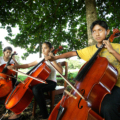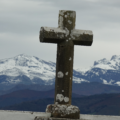Traveling the Jesuit Route or experiencing the Missions Road (an alternative proposal along 750 kilometers through three South American countries that visits seven sites declared Cultural Heritage of Humanity by UNESCO) is much more than a tourist trip or the immersion in the deep memory of Paraguay, a country located in South America. It is that through various paths and roads along hundreds of kilometers is latent that of authentic “spiritual pilgrimage” that also invites reflection and contemplation.
Indeed, through the Jesuit Route in Paraguay, pilgrims have the great opportunity to immerse themselves in the living history of the ancient missionary peoples and soak up the legacy left by the Jesuits – the famous religious order founded by Ignatius of Loyola in the 16th century – among the Guarani (native people).
For this, in addition to a map to follow the itinerary, the first recommendation is to wear comfortable clothes, carry water (as well as other basic elements for the trip) and get ready to enter what many have also called a true transit through the “land of no evil”.
Villa Florida, a city belonging to the department of Misiones on the banks of the Tebicuary River and located about 160 kilometers from Asunción (Paraguayan capital), can be considered the starting point of the Jesuit Route. It is there where several towns of Jesuit Guarani origin are located, such as San Ignacio Guazú, Santa María de Fe, Santa Rosa de Lima and Santiago Apóstol.
It is in this area of Paraguay where the pilgrim appreciates the logo of the Society of Jesus (distinctive of the Jesuit Route) that will receive him for a transfer only comparable in beauty, historical, religious and even nature content, as stated by the promoters of the route, with the famous Camino de Santiago in Spain.
In places like San Ignacio de Guazú – the first city to be founded, in 1609, by the Spanish Jesuits Marcial de Lorenzana and Francisco de San Martín (although it was the Creole father Roque González de Santa Cruz – the first Paraguayan saint – who established it because he spoke Guaraní and taught the other priests) – it is possible to glimpse the San Ignacio de Loyola Church.
But the pilgrim will also find in these towns museums and amazing polychrome wood carvings of religious images. For example, the Diocesan Museum of Baroque Art in San Ignacio de Guazú, a place of reference when it comes to contact with the wonderful representations of the Hispanic-Guarani baroque, something that was made possible by the Jesuits in Paraguay.
About 15 kilometers away, already in Santa María de Fe, besides the contact with local artisans (the works in wool and linen stand out), the pilgrim can also visit the Diocesan Museum of Jesuit Guarani Art of Santa María de la Fe, which keeps the particularity of being one of the best preserved ancient buildings in the department of Misiones. At the same time, the tour offers the possibility of locating some picturesque ranches that offer lodging services and even the possibility of participating in farm activities, as the promoters of the Jesuit Route add.
In another of the missionary towns, in Santa Rosa de Lima (about 28 kilometers from Santa María de Fe), there are other attractions for pilgrims such as the Church of Santa Rosa de Lima, rebuilt after a fire in 1883, as well as the nearby Loreto Chapel, which houses magnificent works of Jesuit art (the chapel has been reconditioned as the smallest museum of the Jesuit Route).
Later, in the other of the Misiones towns as Santiago Apostol – located about 28 kilometers from Santa Rosa de Lima and recognized as “the purest heart of the missionary tradition” and characterized by being one of the smallest missions, the itinerary can be completed with the Church of Santiago Apostol itself built more than 300 years ago, in addition to the Diocesan Museum of Jesuit Guarani Art Saco de Santiago, positioned near the church, which complements the cultural experience of exhibiting statues, paintings and vestiges of the old church.
It is in this area, also about 15 kilometers from the urban center of Santiago Apostle, where a true “spiritual oasis” emerges for any pilgrim or visitor to the Jesuit Route: the Benedictine Monastery Tupâsy María, the first of its kind (male) in Paraguay, founded in 1984.
It is possible to visit the place either accompanied or alone, due to the presence of a lodging area for pilgrims and tourists. On the other hand, in addition to a place conducive to silence and even with a temple where you can see the image of Benedict of Nursia young (something not so common), the area surrounding the monastery invites to walks. It is in this place where it is also possible to buy products made by the monks themselves.
The magnanimity of the Jesuit Missions
Another stage of the itinerary of the Jesuit Route is located in the department of Itapúa, a site located a little more than 200 kilometers from Misiones and almost 400 kilometers from the capital Asunción, so it is advisable to reach the area by some means of transport, an instance that also serves as an excuse to contemplate a beautiful natural landscape.
It is in Itapúa where four other towns of Jesuit Guaraní origin are located, such as San Cosme y San Damián; Santísima Trinidad del Paraná; Jesús de Tavarangüe, and Encarnación de Itapúa, a place where the figure of the Jesuit father and only Paraguayan saint (until now) San Roque González de Santa Cruz became a protagonist.
It is in Itapúa where the pilgrim will be able to glimpse part of the most famous legacy of the Jesuits in South America: the Jesuit Guarani Missions with what represents the magnificence and beauty of the architectural remnants of the set of reductions and in particular some that have even been declared by UNESCO world heritage of humanity as the Jesuit Guarani Mission of Jesus de Tavarangüe, which stands out as one of the “most complete expressions of Jesuit urbanism” (one of the most striking aspects is that this mission would have had one of the largest churches in the region). The same is true of the Jesuit Guarani Mission of Santísima Trinidad del Paraná, which is considered “the largest and best preserved” of the reductions established in the Jesuit Province of Paraguay between the 17th and 18th centuries. Between these two missions there are about 16 kilometers of distance.
A little farther away (also in Itapúa), about 116 kilometers from Santísima Trinidad de Paraná, is the Mission of San Cosme and San Damián, which stands out for its well-preserved ruins, an impressive collection of images carved by Guaraní and Jesuits, as well as a Jesuit school that has been standing since that time and is representative of the rest of the reductions. But at the same time this mission is recognized by the leading role of the Jesuit Buenaventura Suarez, who arrived there from Santa Fe (Argentina) in 1703 and began studies and work on astronomy, an aspect that made him famous also in Europe.
Finally, with respect to these missions, a fact to keep in mind is that each one has a particular design and attraction; in addition to offering the pilgrim special experiences ranging from the possibility of a nighttime cultural tour of “Lights and Sounds” (Mission of Santísima Trinidad), and the 3D video mapping show at the Mission of Jesús de Tavarangue. There is also the opportunity to appreciate the firmament at the Buenaventura Suárez Astronomical Interpretation Center at the San Cosme y San Damián Mission.
Meanwhile, in the midst of these missions, another unavoidable place that is part of the Jesuit Route is the city of Encarnación (located more than 300 kilometers from the capital Asunción and bordering Posadas in Argentina), the third largest and economically most powerful city in Paraguay. Also known as “The Pearl of the South”, it is precisely the capital of the Jesuit Route and of the department of Itapúa.
In the city of Encarnación, one of the most outstanding sites for pilgrims and visitors is the cathedral of Encarnación itself, one of the most important buildings that have accompanied the development of the city. It is in Itapúa, about 14 kilometers from Encarnación, where another of the most picturesque points of the Jesuit Route also stands out: the Sanctuary of the Virgin of Itacuá, a place of reference in terms of peace, the beauty of the landscape and prayer in Paraguay.
Finally, continuing the journey, and as an eventual last stage of the itinerary of the Jesuit Route, the pilgrim would have to travel by some means of transportation to the department of Alto Paraná, a site located a little more than 230 kilometers from Encarnación. It is in that place where you can contemplate extraordinary natural beauties such as majestic reserves and waterfalls, among them Salto del Monday, places that for many even remind, for its landscapes, the movie “The Mission” (1986 British film directed by Roland Joffé and starring Robert De Niro, Jeremy Irons, Ray McAnally and Aidan Quinn) and some touching scenes (although it has not been the exact location of the filming) as when a religious is thrown into the falls by the Indians.
All this in the middle of an ambitious itinerary that is complemented not only with the layout of the pilgrims, but also with the possibility of getting in touch first hand with the most varied handicrafts, comfortable accommodations. But also with a delicious gastronomy, as well as the sympathy of enthusiastic guides, hospitable people, picturesque events and incomparable attractions. This -and more- is what confirms the Jesuit Route in Paraguay as an authentic pilgrimage experience through the “land of no evil”.




